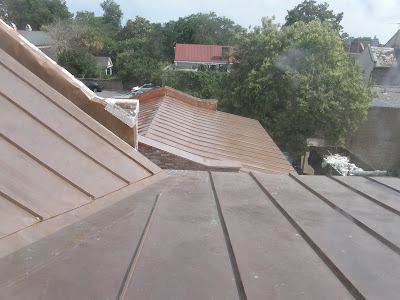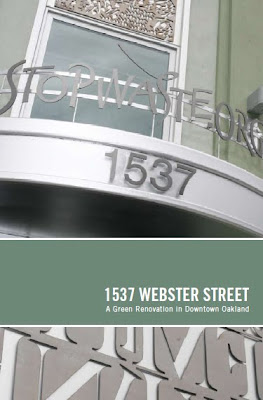A former classmate of mine who is working on a LEED renovation project for Meadors Inc., contacted me recently with two questions. What’s the SRI for copper, and for materials that patina over time do you submit the original SRI value or the aged SRI value for SSc7.2 Heat Island Effect, Roof? I didn't know the answer to either question, but after searching I was able to track down Paul Berdahl of the the Lawrence Berkeley National Laboratory's Heat Island Group, who was kind enough to offer to run tests on a few samples of various ages. You can see how quickly the patina changes in the photo below, where the most recently installed roof is in the background:

Photo Credit: Meadors, Inc.
The results for the samples are as you might expect; the copper has a high SRI when new but quickly loses reflectivity as it patinas with time. Strangely when it gets really old it starts to climb up in SRI value again, though not enough to put you in compliance with LEED's requirements. Here's a table of the results:
| Description | Appearance | SRI | Solar Reflectance | Thermal Emittance |
| New | Bright Copper | 69 | 0.758 | 0.045 |
| 2 Weeks Old | Bright Copper w/ Slight Smudges | 62 | 0.729 | 0.028 |
| Approx. 1 Year Old | Brown w/ Green Flecks | 2 | 0.176 | 0.642 |
| Approx. 5 Years Old | Brown | 4 | 0.190 | 0.654 |
| 50-75 Years Old | Brown w/ Light Green Spots and Streaks | 14 | 0.245 | 0.688 |
Use the above figures at your own risk (this is in no way an 'official' USGBC accepted set of SRI values), but reason would dictate that most copper roofs would have the same characteristics. The question still remains about which value to use, and that is open to some interpretation.
Credit interpretation rulings for SSc7.2 yielded no inquiries about materials that have a non-stable SRI value. Although this is simple conjecture, given the rapid deterioration in SRI for copper (non-compliant within a year, likely much sooner), I would suggest that this product is not in compliance with the intent of the credit which is to reduce heat islands. Clearly for the majority of the life of the copper roof will help foster heat island issues and not reduce them.
What if there are products that deteriorate more slowly, or even become more reflective over time? If I were to write my own credit interpretation request on the subject, I would propose developing a sort of weighted SRI over the course of the expected life of the product, likely a difficult task. What I mean in simple terms is that if we had a product expected to last ten years with an initial SRI of 100 and an SRI of 0 on year ten then the 'weighted' SRI would be 50 assuming a linear decline (90 after one year, 80 after two, etc.). A product such as copper that has some crazy parabolic arc would probably require an excel spreadsheet (or graphing calculator) to determine the lifetime average, but clearly the number for copper would be so low that it's probably not worth the effort. If you've already been through this situation and gotten an official ruling PLEASE share by leaving a comment!
This post wouldn't have been possible if it weren't for the nice folks at Meadors Inc. agreeing to share the results of these tests with all of you and the guys at LBL for doing the testing in the first place. The projects that spurred this post are two historic renovations in the epicenter of Charleston, SC's historic district, 93 Broad St. and 97 Broad St., hence their restriction to use appropriate copper roofing products. You can view galleries of the projects at the links above. Many thanks!






